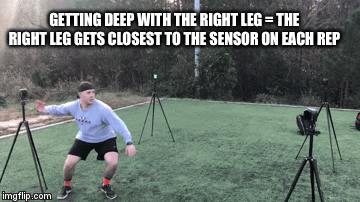#HolisticDevelopment MicroGate WittySem
Explore tagged Tumblr posts
Text
Exploring Man in the Box: A True Agility Assessment
What is Man in the Box (MITB) + What is true agility?
The MITB assessment involves an athlete starting in the middle of a 10 ft. by 10 ft. “box” with a Witty Sem “sensor” positioned in each corner of the box. For the first assessment, the athlete is looking to capture 10 randomly-ordered, ‘green boxes.’ For the second assessment, the athlete is looking to capture 10 randomly-ordered, ‘green 3’s’ and the challenge is increased for the brain by introducing a variety of colors, numbers, and shapes. See the video below for a demonstration of both:
youtube
MITB is a measure of true agility. In all sports, athletes are constantly changing direction based on what they are reacting to in their environment – why should we train or assess any differently? True agility involves a reaction component (uses your brain like 99% of competitive environments) that a typical 5-10-5 shuttle or agility ladder does not (more on that later).
If the ‘green 3’ time is slower than the ‘green box’ time, this means that the athlete’s brain is slowing their body down – that’s okay, it’s not abnormal and brain speed can be trained!
CHECK OUT BRAINHQ AND THEIR RESEARCH-BACKED BRAIN GAMES
How to correctly maneuver the MITB assessment.
It is important to acknowledge that there is a correct way to maneuver the MITB true agility assessment so that we can regulate, track and compare results. Provided no further direction other than “capture 10 green boxes as fast as you can,” there is potential to see a variety of approaches to the task. Some general rules to consider:
1. The athlete should always return to the middle of the box in between trials and should always keep their feet moving.

2. The athlete should avoid stopping and should not go directly to the next Witty Sem.

3. If the athlete returns to the middle of the box in between triggering each Witty Sem, the athlete will travel 141.4 ft. over the course of the 10 trials regardless of the order in which the ‘green boxes’ or ‘green 3’s’ appear.

From the middle of the box to the sensor and back is ~14 ft. - multiply that by 10 = ~140 ft. in total distance.
4. The athlete should alternate getting deep with their right and left leg so as to equally engage both legs in the assessment.
See below for demonstrations of getting deep with the right and left legs:


Define your rules for the athletes so that you can compare apples to apples!
Isolating 1 Leg MITB Modification in Training
As we just explained, it is important to alternate getting deep with the right and left leg during the MITB assessment. Why? An athlete that has a stronger right leg than left leg (see Matt from a previous post) could favor planting and exploding with their right leg in order to complete the MITB assessment quicker. That being said, Matt performed the MITB assessment 15 times in random order. 5 times he got deep with the left leg only, 5 times he got deep with the right leg only, and 5 times he alternated and got deep equally with the left and right legs. See the video below for reference:
youtube
What we found is that Matt was much quicker, on average, when he got deep with his right leg only (13.81 sec). When he alternated, he was a tick slower (14.34 sec), and when he got deep with his left leg only, he registered his slowest times in the assessment, on average (14.73 sec). See the visualization below:

Matt was almost a full second quicker on average when going exclusively deep right vs. deep left. Prior objective exploration in the Drift 2D Protocol, Single Leg MITB, and OF Assessment 2.0 showed the same right>left imbalance. Knowing that the left leg has some catching up to do, Matt could probably use the MITB Deep Left modification in training to strengthen the left leg.
Why True Agility?
When we watch professional athletes, we often see incredible displays of strength, speed, and power. What we often don’t consider is the elite speed at which their brains function and make decisions! Imagine being a quarterback with a slow brain, reading a defense with four 300+ lb. defensive linemen rushing you – probably not a good time.

The MITB assessment factors in a cognitive element that is present in almost all competitive environments. Using the MITB and getting the brain involved is a critical component to training agility that can transfer into the competitive environment. The well-known 5-10-5 shuttle allows the athlete to anticipate their change of direction and mindlessly execute the pre-determined route. Additionally, many trainers and coaches utilize ladders to train or assess agility. Per Kaitlyn Weiss, Sports Science Coordinator with the Los Angeles Dodgers:
“Previous studies looking at agility determined that reaction time (decision-making time) is highly influential on agility performance. To enhance agility, then, you must develop decision-making skills [1]. Again, with agility ladders, there is no stimulus to react to, and therefore no decision-making required.”
Weiss concisely debunks agility ladders in a 2017 article linked here: Agility Ladders are Built on a Lie
Defining Statement on MITB
It is important to attempt to train agility and other skills in as close to a sport-specific context as possible. The MITB assessment is not sport-specific. That being said, agility and the movements associated with agility are going to vary from sport to sport, so a universal agility assessment is near-impossible to attain. The MITB assessment is not perfect, but it is a much better alternative to the 5-10-5 shuttle or an agility ladder in training and assessing true agility in a non-sport-specific context.
0 notes